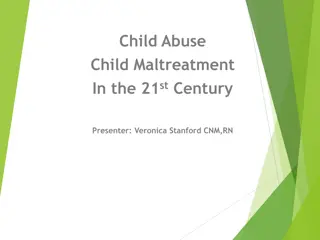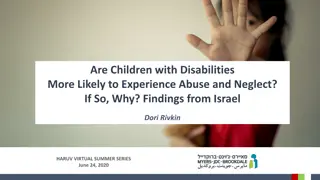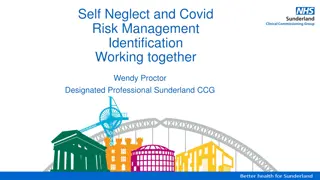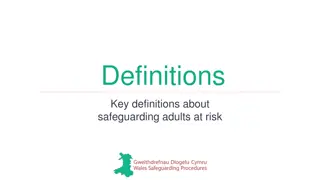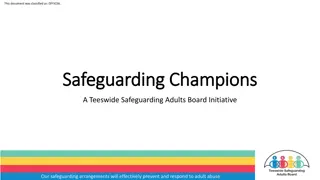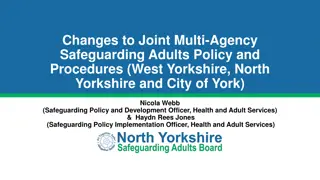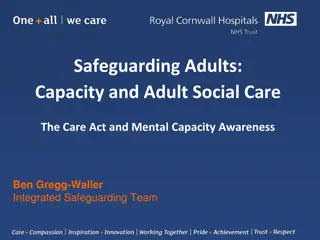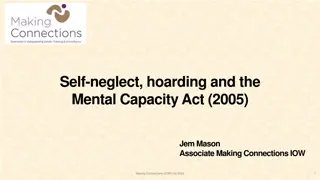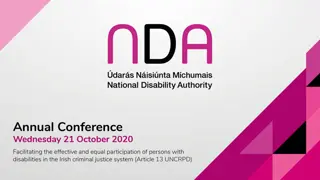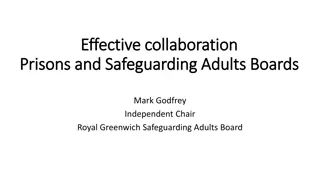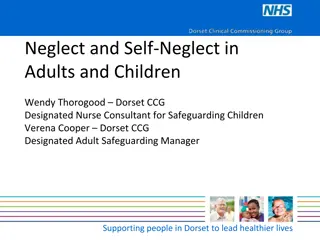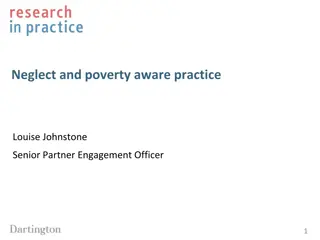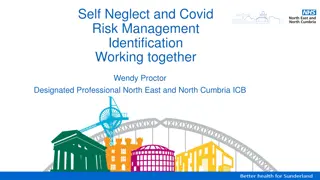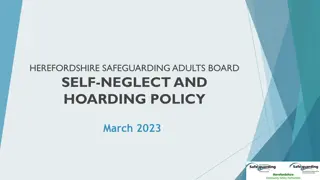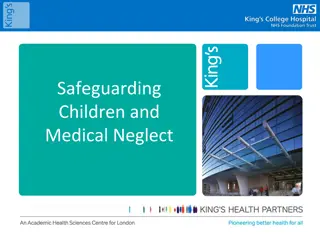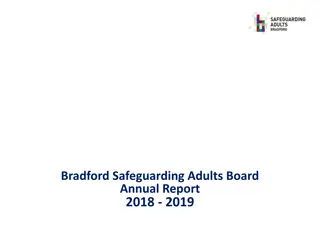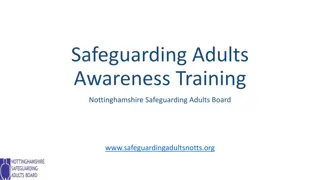Understanding Self-Neglect and Safeguarding in Adults
Self-neglect in adults involves a lack of self-care, neglect of personal hygiene, health, and domestic environment, as well as refusal of services. It can stem from physical or mental health issues, past trauma, hoarding as a coping mechanism,and low self-esteem. Learning about policies, Mental Capacity Act, and local guidelines is crucial in addressing self-neglect effectively.
Download Presentation

Please find below an Image/Link to download the presentation.
The content on the website is provided AS IS for your information and personal use only. It may not be sold, licensed, or shared on other websites without obtaining consent from the author. Download presentation by click this link. If you encounter any issues during the download, it is possible that the publisher has removed the file from their server.
E N D
Presentation Transcript
Self Neglect and Learning from Safeguarding Adults Reviews (level 3) Louise Leach: B&NES, Swindon and Wiltshire Clinical Commissioning Group, Named GP Safeguarding Adults BaNES Locality Karyn Yee-King: B&NES Council, Principal Mental Health Social Worker and Mental Health Manager Helen Wakeling: B&NES Council, Principal Social Worker: Safeguarding and Quality Assurance
Aims and Learning outcome Aims and Learning outcome Know how to access and use the Self-Neglect Policy Recognise the principles of the Mental Capacity Act Recognise what makes a good Mental Capacity Assessment Ensure you have seen and documented any legal powers related to your client Implementing the learning for Recent Safeguarding Adult Reviews (SAR) Understanding how Self-neglect and Safeguarding work in synergy
Understand your local Understand your local Self- -Neglect Policy and Guidance Neglect Policy and Guidance Self The BaNES LSAB developed the new policy and guidance between June2018-March 2019 https://bswccg.nhs.uk/for- clinicians/safeguarding/adult-safeguarding/banes- locality/1239-self-neglect-self-neglect-policy-and- guidance-march-19/file following 3 local SARs (John/C/Jane) A lot of practitioners not aware there was a policy Unclear whether self-neglect = safeguarding The policy has been further developed following learning for more local SAR s Elley and Mark
Self Self- -neglect is generally made neglect is generally made up of three elements: up of three elements: Lack of self-care (for example, neglect of personal hygiene, nutrition, hydration and/or health) Lack of care of the domestic environment (for example, squalor or hoarding) https://www.bswccg.nhs.uk/for- clinicians/safeguarding/adult-safeguarding/banes- locality/1718-clutter-image-rating/file and/or Refusal of services that would mitigate risk to safety and wellbeing. (Braye, Orr and Preston-Shoot, 2015 )
Causes of Self Causes of Self- -Neglect Often links to physical or mental health issues, disability, or substance misuse Neglect Sometimes issues rooted in the person s life history e.g. past trauma or experience of loss Sometimes a coping mechanism: e.g. hoarding might be an active way of dealing with experiences and emotions that would otherwise be overwhelming, and giving up the hoarded possessions would leave an unbearable gap Sometimes chronic low self-esteem Sometimes homelessness or suffering from poor health
Multi Multi- -Agency Risk Management Agency Risk Management (MARM) meeting (MARM) meeting If you suspect self-neglect consider organising a MARM Develop a plan which should be regularly reviewed Consult the person you are concerned about to tell them your concerns Agree who is the lead agency If care and support needs are identified request a care act assessment Always consider Mental Capacity and best interest decision making Any agency or individual that is concerned that the Self-Neglect Plan is not reducing risks to an acceptable level should raise a safeguarding concern.
Self-Neglect Multi-Agency Risk Management Meeting Draft Agenda (Appendix B in policy) - Roles of agencies/professionals/individuals represented 2. Details of the adult at risk of self-neglect - Confirm whether adult at risk is aware of safeguarding alert/procedures in place to manage concerns of self-neglect - Views (if known) of the adult at risk, and the outcomes that they are seeking - Agency involvement (in place/refused) 3. Details of mental capacity - Decision(s) and associated risks and consequences against which mental capacity (including executive functioning ) has been assessed - How capacity assessment was carried out, when and by whom - If mental capacity has been assumed, how has this assumption been reached? - Any identified concerns - Is a legal view required? 4. Assessment of risk indicators - Agree severity of risks identified 5. Practical support and strategies to minimise the risks 6. Agree actions to manage risks and identify triggers for review 7. Communicating with the person at risk - Agree who is best placed to talk to the adult at risk, empower them to make decisions and to take action 8. Agree Lead Agency / Lead Worker to co-ordinate ongoing work 9. Agree Self-Neglect Action Plan / Crisis Intervention Plan 10.Review - agree timescales for review
When does a case become When does a case become Safeguarding ? Safeguarding ? The Care Act Statutory Guidance (2018) states: Self-neglect may not prompt a section 42 enquiry (i.e Safeguarding). An assessment should be made on a case by case basis. A decision on whether a response is required under safeguarding will depend on the adult s ability to protect themselves by controlling their own behaviour. Where there is reasonable cause to suspect that the adult is unable to protect him or herself from self-neglect or the risk of it as a result of their care and support needs, and the risk is high or very high, a Safeguarding concern should immediately be triggered. This will also be the case where previous attempts to work in a multi-agency way (as set out above) have failed to produce a reduction in risk. 9
Barriers to good practice Barriers to good practice People who self-neglect may refuse support or fail to acknowledge the problem. (do they have care and support needs?) There can be pressure on professionals to take action, but often very little they can do. There is often a lack of clarity about who should take responsibility for supporting people who self-neglect. Work patterns and resources don t always support long- term, relationship-based work. Information sharing is sometimes problematic, particularly when the person refuses help. Limited legal literacy professionals may not have a good understanding of the law that can be utilised in relation to self-neglect. Application of the Mental Capacity Act can be very complex in relation to self-neglect. SCIE- self neglect at a glance Oct 2018 https://www.scie.org.uk/self-neglect/at-a-glance
A strategy for good practice A strategy for good practice Access to an agreed policy and guidance on self-neglect a multi-agency shared ownership, risk assessments and management agreed at all levels the Mental Capacity Act is well understood and implemented in the context of self-neglect; making sure that the presence of mental capacity is not used as a justification for inaction a clear record is made of all decisions and there is time for long term work to be supported. training, supervision and support is available for staff dealing with people who self-neglect recognising the complexity of this area. SCIE- self neglect at a glance Oct 2018 https://www.scie.org.uk/self-neglect/at-a-glance
GMC Guidance for doctors decision making and consent https://bswccg.nhs.uk/for-clinicians/safeguarding/adult- safeguarding/banes-locality/1615-mca-gmc-guidance-for-doctors- decision-making-and-consent-english-pdf-84191055/file The seven principles of decision making and consent Principle one All patients have the right to be involved in decisions about their treatment and care and be supported to make informed decisions if they are able. Principle two Decision making is an ongoing process focused on meaningful dialogue: the exchange of relevant information specific to the individual patient. Principle three All patients have the right to be listened to, and to be given the information they need to make a decision and the time and support they need to understand it. Principle four Doctors must try to find out what matters to patients so they can share relevant information about the benefits and harms of proposed options and reasonable alternatives, including the option to take no action. Principle five Doctors must start from the presumption that all adult patients have capacity to make decisions about their treatment and care. A patient can only be judged to lack capacity to make a specific decision at a specific time, and only after assessment in line with legal requirements. Principle six The choice of treatment or care for patients who lack capacity must be of overall benefit to them, and decisions should be made in consultation with those who are close to them or advocating for them. Principle seven Patients whose right to consent is affected by law should be supported to be involved in the decision-making process, and to exercise choice if possible.
GMC guidance cont. 94 A patient s right to make a healthcare decision for themselves can be affected by mental health or other legislation and by common law powers of the courts. Patients may be required by law to comply with assessment or treatment because they present a risk to themselves, to their health or to others. There are strict safeguards around using these legal powers to restrict or restrain individuals, and these determine what is permitted without consent. You should be aware of what treatment is, and is not, legally permissible. 95 If you consider it necessary to use these legal powers to treat or assess a patient without consent, you must follow the procedures set out in the relevant legislation and statutory guidance and in paragraph 96 of this guidance. If you need advice or support, you should contact your defence body or professional association or seek independent legal advice
Mental Capacity Act Mental Capacity Act Simples!! Simples!!
Mental Capacity Act 2005 (MCA) re-cap The Mental Capacity Act is applicable to those aged 16+ (with some exceptions) Provides a legal framework to assess capacity and make decisions on behalf of those unable to make decisions themselves. It promotes the involvement of the person in the decision making and has been noted to be a visionary piece of legislation (The House of Lords)
Principles of the Act A person must be assumed to have capacity unless it is established otherwise A person is not to be treated as unable to make a decision unless all practicable steps to help him do so have been taken without success. A person is not to be treated as unable to make a decision merely because he makes an unwise decision.
Principles continued. An Act done, or decision made, must be done or made in the person s Best Interests Before the act is done, or decision made, regard must be had to whether the purpose for which it is needed can be effectively achieved in a way that is less restrictive of the persons rights and freedom of action.
When should you assess capacity? If concerns have been raised by those involved in the care and support of that person? Inconsistent decision making? Decision making that may be out of character? Ongoing unwise decision making? Where there is a complexity in the presentation? Where there is an established mental disorder?
Decision Specific and Time Specific What is the decision you are needing to assess it is vital that you pin this down from the start and then don t move away from it as the assessment progresses The decision maker should be the assessor however please involve other prof as needed We do not assess for global capacity !!! Are you clear what the potential risks are relating to the decision before you expect the person to understand what they are Do not rely on an old MCA how old is old?
Diagnostic Test Does the person have an impairment of, or a disturbance in the functioning of their mind or brain? Can be permanent or temporary The decision or inability to make the decision needs to be clearly linked back to the mental impairment what is referred to as the causal nexus
A quick word on Executive Functioning This is not a new part of the Act! It refers to the functional test criteria in the MCA It is the manner in which you have worked with the individual to assess whether they have been able to weigh up the information to arrive at a decision
Tips to Assist in the weighing up Have you taken all practicable steps to help the person to understand the information, weigh it up and reach a decision? ( Practicable = realistic in the circumstances.) E.g. Trying to find a better time of day for the person Using pictures, signing, flashcards etc where appropriate Getting a friend or family member to help communication Asking open questions avoiding yes or no answers Ask them to show you how they would do something or ask them to explain the process of how they would undertake a task Checking back that the person has understood each element of your explanation etc etc etc Write it up whilst it is still fresh verbatim recording can be useful
Cautionary Tale on Presumption of Capacity Principle 1 of the MCA is still really important However: We are seeing it being relied on far too often Professionals not providing rationale for why principle 1 of MCA is being used Where there is doubt or complexity err on the side of caution
What Makes a Good MCA Assessment Be clear about the capacity decision that is being assessed; Ensure P (and you) have the concrete details of the choices available Identify the salient details P needs to understand/comprehend; Avoid the protection imperative; do not allow the tail of welfare to wag the tail of capacity Demonstrate the efforts taken to promote P s ability to decide; Evidence each element of your assessment: 1) What is the impairment/disturbance? Is it temporary or permanent? 2) Why could P not understand, or retain, or use/weigh, or communicate in spite of the assistance given? 3) How is the inability because of the impairment/disturbance (as opposed to something else)? Why is this an incapacitated decision as opposed to an unwise one?
Other Bits and Bobs Lasting Power of Attorney don t assume seek proof needs to be registered! LPA does not excuse poor decision making and not acting in person s best interests Any concerns about use of LPA should be referred to Office of Public Guardian Other legal avenues if person has capacity e.g. Inherent Jurisdiction, Environmental Laws NB a lack of capacity is not an off switch for the person s rights and freedoms
Making Decisions for those who lack capacity Best interest Decision Making Depends on the person s age. MCA Best Interests checklist always for those 18+, MCA Best Interests checklist and/or Parental Responsibility for 16-18yrs (Code of Practice 12.16) Court of Protection if lack of agreement or complexity. It is a process of constructing a decision on behalf of the person who cannot make that decision themselves.
MCA Best Interests Checklist things that MUST be considered Encourage Participation do what is reasonably practicable to facilitate this. Identify all relevant circumstances all issues and circumstances, including options, that are relevant to the person and the decision to be made. Find out the person's views current and previous views and wishes, beliefs and values, other factors P would have taken into account. Avoid discrimination Do not make assumptions based on characteristics or diagnosis.
Best Interests Checklist continued Assess if the person will regain capacity can the decision wait if this is likely? Is the decision about life sustaining treatment cannot be motivated by desire to bring about the persons death. Consult others those named by P now or previously, those involved in caring for P, family, carers, LPoA and Deputy. Avoid restricting rights least restrictive option should always be priority.
Application of the checklist Provide details of every option available for the person (including doing nothing) Draw up a balance sheet detailing the factors for and against each of the options including risks and benefits. Note the likelihood of the pros and cons of each option eventuating. Give weight to each factor and highlight those which are considered to be more important. There may be a factor of magnetic importance which overrides numerous other factors.
Making the decision Write a conclusion detailing reasons for identifying a particular option as being in Person s best interests and for rejecting the other options. Be especially clear about the reasoning if there is dispute about the decision, there is a significant impact on Person s Rights or you are overriding Person s wishes. Be clear as to why a less restrictive option course cannot be taken show your working out!
Best Interests straightforward???? No guidance about weighting given to each part of the checklist will depend on the individual. Competing views and opinions from P, family, carers and professionals. Case law has been suggesting a move towards the wishes of the person above risk issues, but not in all cases very much dependant on the circumstances of the particular case. Court of Protection to resolve any disputes that cannot be managed informally
MCA vs MHA What is the outcome you are looking for? Is it treatment for a mental disorder or a health need? Is the health need related to an acute mental disorder? Be led by advice from AMHP or MCA/DoLS team P can be admitted to acute hospital under MCA even for mental disorder v complicated issue! MHA is changing to be aware more attention to rights based decision making aligning with MCA principles
Learning from Local Learning from Local Safeguarding Adult Reviews (SAR) Safeguarding Adult Reviews (SAR)
Learning from Learning from SAR Elley Elley and SAR Mark and SAR Mark SAR Supporting the Person Have a Lead Professional (Elley) Make sure that all the person s needs are considered together don t work in silo s (Mark) Share the risk management plan with all those working with the person and make sure they understand it (Mark) Monitor non attendance at key appointments and follow up (Mark)
Learning from Learning from SAR Elley Elley and SAR Mark and SAR Mark SAR Supporting the Person Providers should confirm they can meet all the need s they are being asked to support (Mark) Legal advice how is this accessed (Mark) Record of legal options considered and why not pursued. (Mark) Provide people with relevant information (Elley)
Learning from Learning from SAR Elley Elley and SAR Mark and SAR Mark Safeguarding All staff need to be aware of the safeguarding process (Mark) SAR This includes knowing about the escalation process (Mark) Urgent action must be taken to keep the person safe do not wait for the safeguarding process (Mark) Let the person know you are referring them unless doing so would put them at risk (Elley)
Learning from Learning from SAR Elley Elley and SAR Mark and SAR Mark SAR Safeguarding If its an ongoing situation include in the safeguarding concern: Why is this referral is being made now what has changed What steps have already been taken Why did they not work do you think Need for a social care or carers assessment should be considered as part of the safeguarding consideration.
S42 Enquiries S42 Enquiries What is a S42 (1) and S42 (2) (1) and S42 (2) What is a S42 s42 (1) initial enquiries s42 (2) decision Safeguarding criteria what are the person's wishes and understanding of the risk decision by Chair as to what actions are required and by whom what support do they have / need does the person have care and support needs decision by Chair whether further enquiries are required, safeguarding what immediate actions are needed /have been taken to manage the risk are they experiencing or at risk of abuse or neglect concern are they unable to protect themselves as a result of their needs if s42 enquiry is complete - Chair advises worker of any actions and asks to complete closure are there alternative actions (eg assessment) to address the concern identified if yes, progress to enquiry s42 (1) any other relevant information if further enquiries are required - Chair advises worker to arrange planning discussion/ meeting if no, safeguarding criteria not met; consider appropriate response, eg assessment/ signposting. As a result of the above, has the concern been addressed? Are further enquiries are required? progress to S42 (2) enquiry
References References Braye S, Orr D and Preston-Shoot M (2015) Practice tool: Working with people who self-neglect. Dartington; Research in Practice for Adults DH (2016) Care and support statutory guidance. Updated 9th May 2016. Available online: https://www.gov.uk/government/publications/care-act-statutory- guidance/care-and-support-statutory-guidance SCIE Self-neglect resources and services: https://www.scie.org.uk/atoz/?f_az_subject_thesaurus_terms_s=self- neglect&st=atoz Avon Fire & Rescue : clutter Image Rating Scale (CIRS) https://bristolsafeguarding.org/media/1126/clutter-image-rating.pdf Age UK (dec 2019) Factsheet 78 safeguarding older people from abuse and neglect https://www.ageuk.org.uk/globalassets/age- uk/documents/factsheets/fs78_safeguarding_older_people_from_abuse_fcs.pdf GMC guidance https://www.gmc-uk.org/-/media/documents/gmc-guidance-for- doctors---decision-making-and-consent-english_pdf- 84191055.pdf?la=en&hash=BE327A1C584627D12BC51F66E790443F0E0651DA BaNES self neglect policy self-neglect_policy_and_guidance_.pdf (bathnes.gov.uk)


